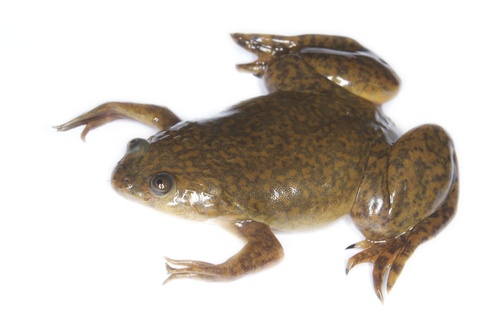
African Clawed Frog
The African clawed frog thrives in warm, stagnant waters. Its distinctive claws and vocal abilities make it a fascinating subject of study. Playing a vital role in aquatic ecosystems, it preys on invertebrates and helps control insect populations.
8-15 years
Lifespan
25.0 - 220.0 g
Weight
Length: 3 - 12 cm
Size
Brown, Grey, Albino
Color
10-12 months
Age of Sexual Maturity
5 mph
Top Speed
Least Concern
Conservation Status
Increasing
Population Trend
Characteristics
Xenopus laevis, also known as the African clawed frog, is an aquatic amphibian native to sub-Saharan Africa. It has smooth, slippery skin, and distinctive clawed toes on its hind feet. This species is known for its unique method of communication through underwater vocalizations and its ability to regenerate body parts.
Distribution Range of the African Clawed Frog
Xenopus laevis, commonly known as the African clawed frog, is native to sub-Saharan Africa. It is primarily found in countries such as South Africa, Namibia, Botswana, Zimbabwe, Mozambique, and parts of Zambia and Malawi. The species has also been introduced to various other regions around the world, but its natural range is primarily confined to the southern and eastern regions of Africa.
African Clawed Frog's Habitat
Environmental Conditions
Xenopus laevis typically inhabits freshwater environments such as ponds, lakes, and slow-moving rivers. These environments often have muddy bottoms and abundant aquatic vegetation. The species is highly adaptable and can tolerate a wide range of environmental conditions, including fluctuations in temperature and water quality. They are known to thrive in both permanent and temporary water bodies.
Ecological Niche
The African clawed frog is a fully aquatic amphibian that occupies a niche as a bottom-dwelling predator. It feeds on a variety of aquatic organisms, including insects, small fish, and other invertebrates. The species is well adapted to its aquatic lifestyle, with specialized limbs for swimming and a lateral line system for detecting movements in the water. Xenopus laevis plays a crucial role in its ecosystem by controlling insect populations and serving as prey for larger predators.
Copyright @ Nature Style Limited. All Rights Reserved.
 English
English